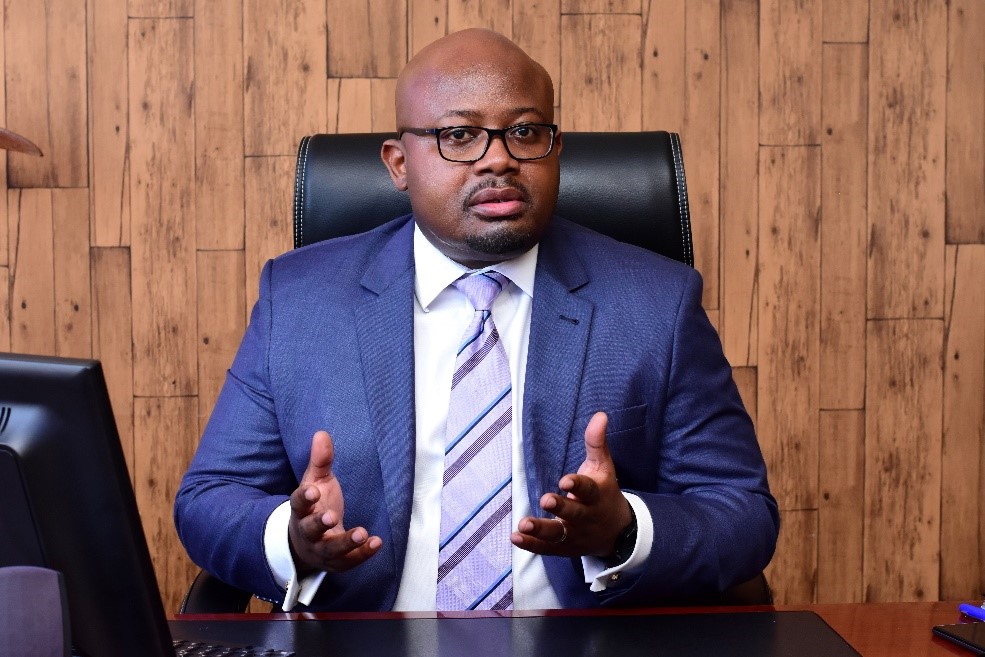
In 2017, the Government sponsored the enactment of the Movable Property Security Rights (MPSR) Act to enable instant and efficient registration of security rights of movable properties through an electronic system. The system promotes access to credit for Medium, and Small Enterprises (MSMEs), low-income earners and other owners of movable assets. MyGovwriter, Mutiso Mbithi interviewed the Director-General of the Business Registration Service (BRS) MR. KENNETH GATHUMA who sought tocreate awareness on this relatively new concept.
Briefly take us through the Movable Property Security Rights (MPSR) e-Collateral Registry and what it entails.
The e-Collateral Registry was a business focused reform aimed at improving access to credit in Kenya. It is a fully electronic registry established under the Movable Property Security Rights Act of 2017. It is hosted at BRS and is accessed through the e-citizen platform and allows for remote, instant and timestamped registration of security rights in movable collateral. The Registry allows borrowers to use movable assets as collateral to access credit (financing) which is of critical importance to businesses at large, but more so in the small and micro-enterprise sectors of our economy.
What is the role of BRS in the MPSR ecosystem?
BRS hosts the Movable Property Security Rights Registry online at brs.ecitizen.go.ke. The Registry is mandated to receive, store and make accessible to the public information on registered notices with respect to security rights and rights of non-consensual creditors.
President Kenyatta signed into law the Movable Security Rights Bill 2017, a legislation aimed at facilitating the use of movable property as collateral for securing credit. Briefly take us through the journey of the MPSR regime and how it is different from Chattels?
In the past, the main statutes governing use of movable property as collateral for credit were the Chattels Transfer Act, the Pawnbrokers Act, the Agriculture Act, the Stamp Duty Act, the Hire Purchase Act, the Business Registration Services Act, the Companies Act, the Insolvency Act, the Law of Contract Act, the Banking Act, the Auctioneers Act, the Registration of Documents Act and the Traffic Act. This regime was problematic and full of challenges. Multiplicity of laws was an issue as evidenced by the large number of statutes that governed movable property lending. This created difficulty in establishing credit histories and creation of priority rights especially because the registries were physical and the processes were manual. There existed an extremely weak and disorganised legal framework for use of personal property as security for credit. There was no clear scope or definition of such assets. Even without a clear definition, the scope of personal property was seriously limited and did not envision use of assets such as intellectual property, livestock, and crops among many others. The enforcement mechanisms were weak, lengthy, costly, and substantially limited.
The MPSR Act, 2017 is at the very heart of your work, what do you consider as the big wins for citizens and businesses that use the MPSR E–Register?
The Act has enabled instant, remote and efficient registration of security rights of movable properties through an electronic platform. It has provided for the promotion of access to credit for MSMES, low-income earners, and other owners of movable assets. The MPSR registry has consolidated and strengthened the registry system. Finally, the ability of lenders to realize their security has been simplified. The value of credit that has been unlocked by these diverse forms of assets that are now used by borrowers has risen to trillions of shillings thus creating a positive impact to businesses in Kenya as envisioned in the economic pillar of the Kenya Vision 2030.
Since the operationalization of the collateral registry system, which are some of the types of collateral used?
These include household items, motor vehicles/trailers, furniture, equipment’s or machinery, livestock, inventory including stock-in trade, Deposit/ Bank accounts, all present and after acquired property, Securities, Crops, Intellectual property, Negotiable documents, Consumer goods other than household items, negotiable instruments.
Could you give us some statistics on this?
Let me start by highlighting that household items are the most popular collateral used by borrowers with 427,429 items having been registered with creditors as at June, 2021 compared with the data in 2019 that stood at 198,873. This is followed by motor vehicles with 206,069, an increase from 86,010 in 2019. Other movable assets that have been registered as collateral include furniture (177,377), equipment (137,493), livestock (58,048), stock trade (54,421), inventory (33,317), bank accounts (11, 896). During the same period, intellectual property registered as collateral stood at (1,115), a jump from 364 in 2019. Crops on farms registered as collateral increased to 3,959 from 2,013. Securities were 5,987 – documents of title that include a bill of lading, dock warrant, dock receipt, warehouse receipt, an order for delivery of goods (969), consumer goods (820) and negotiable instruments (228) were also registered as movable assets.
How many small, micro, medium, large and women led organizations have used collateral to secure credit?
More Micro, Small, Medium and Women led organizations are using movable assets to access credit. This shows an increase of access to credit by MSME’s. In 2020, the number of micro enterprises was (5,252), Small (5,127), medium (2,601), women led organizations (2,289) and large lenders at (984) firms used their movable assets to access credit.
Please highlight the types of guarantors, value and types of collateral used and the lending institutions?
More Individuals are using movable assets to obtain credit, with over 400,354 individuals having registered their assets. In turn, this means that financial institutions are now willing to offer individual credit against movable items due to the reduced risk of credit because of the priority right concept and the enforcement mechanism options offer by this regime. Whereas local company stand at (34,243), local unincorporated (7,057) and foreigners at (1,451).
Is BRS where it had envisioned to be in regard to the use of MPSR and what are some of its milestones?
We have achieved major milestones since the establishment of the e-Registry. For instance, Kenya’s ranking has improved in the ease of doing business with Kenya being ranked 4th out of 190 economies, depicting the strength of credit reporting systems and the effectiveness of collateral and bankruptcy laws in facilitating lending in Kenya. The system has been key in promoting financial inclusion through widening the scope of assets that can be used as collateral as well as widening the scope of secured lenders to include informal lenders. As well, the Registry has brought certainty with regards to priority rights over assets and lenders are now confident to use the registry to lend using movable assets. Access to the Registry has created a verifiable way of establishing ownership of secured collateral, lenders have easy access to the registry rendering credit analysis fast and more efficient particularly in conducting due diligence. The new regime has introduced alternative ways of recovering debts other than the court process thereby lowering the cost and time of enforcement.
Can you assure Kenyans whether MPSR is the place to go for people willing to secure credit in Kenya and how they stand to benefit?
The lenders are able to secure their interests in the collateral used, obtain priority, and explore the various enforcement options available under the law. They can also benefit from the search function to establish whether the collateral offered is free of encumbrance. Further, they can grow their business and widen the customer base by developing new products based on this new regime. Additionally, remote, instant and time-stamped access of the Registry has eased and lowered the cost of doing business for lenders. Borrowers are able to access credit using an array of movable assets that weren’t traditionally used. They can also borrow from a variety of lenders including from natural persons thereby affording them competitive credit terms


